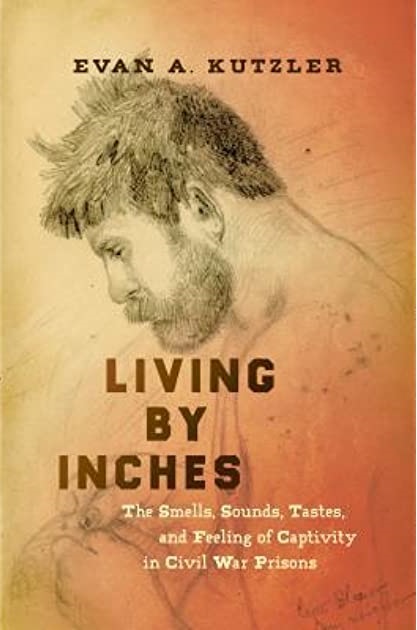by Bryan & Heather
Kutzler, Evan A. Living by Inches: The Smells, Sounds, Tastes, and Feeling of Captivity in Civil War Prisons. Chapel Hill, NC: University of North Carolina Press, 2019.
In the summer of 2013, both of us had the wonderful opportunity to work as interpretive interns for the National Park Service. Bryan gave tours at three Civil War battlefields in central Virginia (Fredericksburg, Chancellorsville, and Spotsylvania), while Heather interpreted history for visitors at Andersonville, the infamous Confederate military prison for captured Union soldiers. Naturally, we each brought no small amount of affinity for the parks away from our experiences that summer, and thus Evan Kutzler’s Living by Inches found its way into our ever-growing library. We recently had the pleasure of reading and discussing it together and found it one of our most interesting and, ironically, refreshing reads in recent memory.
From the first page of Living by Inches, Kutzler is clear what kind of history he is writing. It is not his goal to relate the history of Civil War prison camps, nor to untangle historiographical or public memory debates about which side’s camps were worse and why. Instead, Kutzler is concerned with recreating how prisoners experienced these camps and their time in captivity through each of the five human senses. In so doing, Living by Inches achieves twin heights as both an experiential history and a sociological study of Victorian America. In our experience, most histories—especially academic ones—that claim to study the “experiences” of historical actors (like the now-ubiquitous “common soldier” studies of the American Civil War era) tend to not actually explore what it would be like to live as those individuals, instead getting lost in social, cultural, gender, or intellectual history as expressed through the lives of those actors. Kutzler, however, puts his readers squarely in the middle of a Civil War prison camp, from describing every sensory stimulus prisoners likely encountered to explaining how they would have processed those stimuli based on their socio-cultural milieu. This is historical relativism at its best, demonstrating how even little things like nighttime, cornbread, or personal hygiene could take on radically different meanings only a century and a half ago.
Kutzler’s focus on his material, however, does result in some slips and missed opportunities. Most notable is his use of what he calls “indirect” accounts of some sensory observations. Living by Inches is generally skillful in demonstrating how sources can be read against their grain to extract implicit information, yet sometimes Kutzler can go too far and claim certain connections when the sources can’t quite get him to more than a “possible” level of relevance for that particular reference. Living by Inches is notably a history of white prisoners as well; black soldiers are largely absent, though this is somewhat understandable given the breadth of cultural material that would need to be added to properly contextualize those men’s experiences. Heather was also surprised that Kutzler did not address the mythology of widespread prisoner escapes, though that may stem from his admirable decision to only use contemporary sources, not prisoner memoirs from years later.
Despite these small quibbles, though, we cannot recommend Living by Inches highly enough. It is a highly approachable book on a fascinating topic, and Kutzler manages to balance multiple concerns throughout his scholarship. He focuses on a grim topic, yet never falls prey to the sensationalist or confrontational tropes of “dark history.” He avoids participating in the often-vitriolic debate over culpability for atrocity, yet frankly demonstrates the reality that Union military prisons were demoralizing while the Confederacy’s were dehumanizing. We would not be surprised to see Kutzler’s name pop up in the credits of future period pieces as a consultant; the strength of his analysis and prose here evokes a tangible realism that we’ve seldom seen, and we will follow his future publications with great interest.
